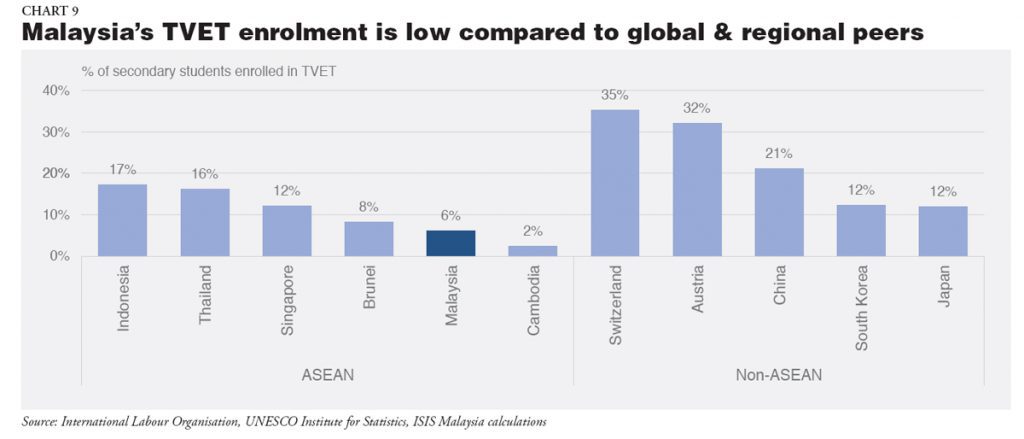This article was first published in the Japan Economic Foundation (JEF) Japan SPOTLIGHT January/February 2020 Issue.
Full Issue: https://www.jef.or.jp/jspotlight/latestissue/
Article Link: https://www.jef.or.jp/journal/pdf/229th_Special_Article.pdf
Context
In recent decades, world governments have been increasingly recognizing that high levels of youth unemployment can have dire and wide-ranging impacts on global economic development. A large body of evidence suggests that being unemployed while young, especially for longer periods, has long-lasting negative effects on future income and employment prospects – in addition to lowering the jobseeker’s mental well-being and life satisfaction for decades (“The Long-term Labor Market Consequences of Graduating from College in a Bad Economy” by Lisa B. Kahn, Labour Economics, April 2010, vol. 17(2); “The Long-Term Effects of Youth Unemployment”, by Thomas Mroz and Timothy Savage, The Journal of Human Resources, 2006, 41(2)). On a macro level, a high percentage of youth unemployment compounds these negative effects, leading to lower aggregate labor productivity and labor force human capital accumulation for decades. There is some evidence to show that youth unemployment in a country produces broader socio-political impacts too, increasing the prevalence of social unrest and crime (“Youth Unemployment and Crime: New Lessons Exploring Longitudinal Data” by Hans Grönqvist, 2011. https://www.sole-jole.org/12129.pdf). As such, addressing problems of youth unemployment and youth upskilling have been recognized in the UN’s Sustainable Development Goals (SDGs), adopted by all United Nations Member States in 2015.
In Malaysia, this is an equally pressing issue. In 2018, the youth unemployment rate in Malaysia stood at 10.9% – lower than the regional average of 12.2% in Southeast Asia and the Pacific (Chart 1), but the third-highest youth unemployment rate in ASEAN after Indonesia and the Philippines. Local policymakers are thus increasing efforts to reduce the magnitude and persistence of youth unemployment, cognizant that as Malaysia continues to climb up the developmental ladder, future economic growth needs to increasingly come from gains in productivity. Additionally, as technological change continues to mount, it is becoming increasingly urgent to prepare the nation’s youth for the labor demands of the future.
Realities of Youth Unemployment in Malaysia
Looking deeper into more detailed statistics from the Department of Statistics and the Institute for Labour Market Information Analysis on youth unemployment in Malaysia reveals some interesting realities:


The first is that youth unemployment in Malaysia is skewed towards teenagers (Chart 2). Breaking down the youth labor force into narrower age bands, the data shows that teenagers (ages 15-19) have far higher unemployment rates than young adults (20-24). Teenage jobseekers are almost 1.7 times more likely to be jobless than young adults – and almost five times more likely to be unemployed than the overall population. As the young adult age group includes a high number of tertiary graduates, while the teenage group will almost invariably exclude tertiary-educated jobseekers, this makes sense from a perspective of increasing returns to human capital accumulation. As such, this highlights a duality in the issue of youth unemployment in Malaysia, showing that there are two separate but inter-related issues of teenage unemployment and graduate unemployment. Yet, it is important to note that, basic and secondary-educated jobseekers have a lower unemployment rate than tertiary-educated jobseekers (Chart 3). This dissonance between the higher teenage unemployment rates and yet lower unemployment rates for basic and secondary-educated jobseekers is potentially explained by differences between the lower-educated young and the lower-educated adults who have already been in the labor force for some time.

Second, the headline average youth unemployment rate obscures a large degree of heterogeneity between regions and between income groups. In reality, there is a significant geographical and income component to youth unemployment in Malaysia. Notably, looking at state-level data (Chart 4), the worst states to look for a job as a young adult (and as a graduate) are Terengganu, Sabah, and Kelantan, which have the highest young adult unemployment rates in Malaysia. This picture shifts slightly when looking at the teenage group – states with elevated rates of teenage unemployment are Perlis, Kelantan, Sabah, and Kedah. This is further supported by the Ministry of Education’s Graduate Tracer Study (various years) which shows that there are indeed significant disparities between the labor market prospects of lower-income graduates and higher-income graduates – and between more developed and less developed states in Malaysia.

Third, while the youth unemployment rate in Malaysia is not immensely high relative to the world average, Malaysia’s youth unemployment-to-total unemployment rate ratio – which is a rough measure of youth employment prospects relative to the overall population – is much higher than the world average (Chart 5). More worryingly, over the last two decades, this ratio of youth unemployment to total unemployment has been rising in tandem with the world average – suggesting that, on average, it has become increasingly hard for young people to find a job today than 20 years ago.
Lastly, it is important to note that youth labor market challenges are broader than youth unemployment. Going beyond just youth employment, yet another major challenge is the proportion of inactive youths in the population, or young people who are not in education, employment or training (Chart 6).


Looking at Some Potential Causes
Two main factors contribute to the relatively elevated level of youth unemployment in Malaysia: supply-side factors and labor demand factors – in addition to other miscellaneous factors relating to information asymmetries, matching failures and intra-country labor mobility.
Supply-side factors: i.e. the characteristics of the youth labor force. Most youths are first-time labor market entrants and have yet to build the information and social networks, and the human capital they need to boost their employment prospects. There is also a sense that education and training (or lack thereof) has not provided young jobseekers with the necessary soft and technical skills they need. A survey conducted by the World Bank and Talent Corporation found that 90% of companies surveyed thought jobseekers needed more industrial training and 81% of companies reported a lack of communication skills as a major problem, while 80% responded that university curricula are not reflective of the current realities (Malaysia Economic Monitor, Towards A Middle Class Society, World Bank (2014); “Youth Unemployment in Malaysia: Developments and Policy Consideration” by Dian Hikmah Mohd Ibrahim and Mohd Zaidi Mahyuddin, Bank Negara Annual Report 2016). On aggregate, a large proportion of Malaysian youth, especially in lower-income areas, continue to have low levels of education and skills (soft and technical skills).
Demand-side factors: Youth unemployment rates are very sensitive to the level of aggregate demand, and thus the pace of economic growth in an economy. During the 2008 global financial crisis, youth unemployment increased at a faster rate than the total unemployment rate. As such, youth unemployment rates are usually the first to increase when aggregate demand in an economy cools. Additionally, potential mismatches between the demand and supply side of the labor market have contributed to higher unemployment rates, and this is especially true for new labor market entrants like the youth. Jobs-added data suggests that the pace of skilled job creation is still relatively slow – annually, more semi-skilled jobs than skilled jobs are created, on average. Overall, the labor market is currently still demanding a relatively low proportion of skilled jobs, though this is changing, with the amount of skilled jobs gradually and steadily inching upwards while the amount of low-skilled jobs has continued to decline (Chart 7 & 8).


Seeking Solutions
So how can public policy work to reduce the incidence and persistence of youth unemployment? We highlight some potential near-term solutions:
Streamlining TVET programs and ensure rigorous monitoring. Both the government and private sectors need to play a role in upskilling and reskilling workers in Malaysia. To date, there are numerous Technical and Vocational Education and Training (TVET) programs provided by seven different ministries at certificate, diploma, and degree levels. This creates an issue of overlapping and redundancies. Consolidating these programs into fewer flagship programs, along with establishing rigorous, measurable monitoring and evaluation mechanisms can help in removing lower-performing programs and improving program administrative capacity.
Additionally, making deliverables and recommendations made under the Cabinet-approved Technical and Vocational Education and Training Empowerment Committee (JKPTVET) public is vital so that stakeholders can give concrete feedback on the recommendations that are proposed (“Roundtable on Current Economic Issues”, ISIS Malaysia, Unpublished Report, Collated Discussion on the RCEI Roundtable Series, 2019). This can narrow the gap between policies and their on-the-ground implementation effectiveness. Building on the newly established committee, upgrading JKPTVET to the ministerial level will also empower the committee to make nationwide changes to the existing programs. This is needed to standardize the existing programs and ensure that monitoring can take place more efficiently.
Improving quality and enrolment of TVET for youths. For youth in particular, research suggests that increasing the quality and access to vocational training is linked to lower rates of youth unemployment (“Youth Unemployment and Vocational Training” by Constanza Biavaschi et al, IZA Discussion Paper No. 6890, 2012. http://ftp.iza.org/dp6890.pdf). Currently, TVET enrolment in Malaysia is low compared to our regional peers (“Labour Market Inventory ASEAN 2010-2015: Labour Market Policy in an Age of Increasing Economic Integration” by Andre Gama, Catherine Saget & Adam Elsheiki, International Labour Organisation report, 2018) (Chart 9). On this, Malaysia can emulate the successful TVET programs introduced in Switzerland, Sweden and Germany (The Future of Jobs Report 2018, World Economic Forum, Geneva). The Switzerland model uses a “dual” vocational education and training system, in which students combine learning in school with learning in workplace settings (“Gold Standard: The Swiss Vocational Education and Training System”, by Nancy Hoffman and Robert Schwart, Washington, DC, National Center on Education and the Economy, 2015). Additionally, adjusting international best practices on TVET for the local labor force through fostering close collaboration between local and international institutions will be beneficial.

Increasing private sector cooperation in apprenticeship, training and internships. Additionally, firms can contribute by improving integration with the local labor market by offering more internship programs, increasing collaboration with colleges/universities and career centers. Further, firms can increase the level of on-the-job training for fresh graduates in the initial year of employment to overcome the issue of skill mismatch. This has worked well in Japan as workers in most of the sectors are re-skilled in the first year of their employment to cater to the demands of the industry.
Hiring experts. In addition to revamping the programs, ensuring that the Department of Skill Development of the Human Resources Ministry is mobilized by specialists with industry knowledge is vital to ensure the staff are aware of the skill-sets needed by local graduates, so that they are able to perfectly match the needs of the industries in Malaysia and beyond.
Concluding Remarks
Research shows that youth unemployment, especially for longer durations, can have persistent and negative effects on the lifetime income and well-being of young jobseekers. This further has effects on the aggregate economy – weighing down productivity and undermining human capital accumulation in the nation’s workforce. In Malaysia, youth unemployment has increasingly been recognized as a pressing issue, amid the forces of technological change and slower structural economic growth rates.
Looking at the labor data, the problem of youth unemployment in Malaysia is multifaceted–having strong age, geographic, and income components. Teenagers are more likely to face unemployment than young adults and graduates; youth joblessness is much higher in relatively lower-income states like Kelantan, Sabah and Terengganu; and is much more prevalent in lower-income, disadvantaged communities. Furthermore, data on job creation and labor force characteristics suggest that a mismatch between the supply and demand sides of the labor market, along with information asymmetries and inefficient matching, has contributed to youth unemployment in Malaysia. Accordingly, we outline some near-term solutions to alleviate youth joblessness, leveraging on evidence of the positive effect of TVET in reducing youth unemployment in developed nations.
This article was first published in the Japan Economic Foundation (JEF) Japan SPOTLIGHT January/February 2020 Issue.





